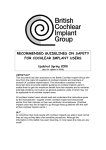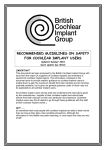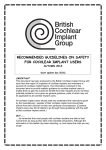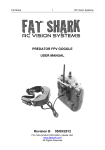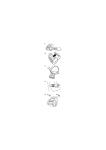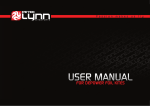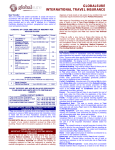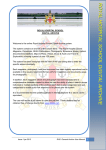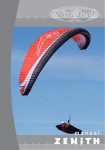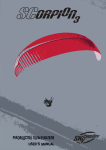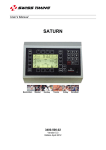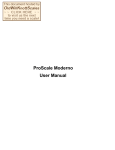Download recommended guidelines on safety for cochlear implant users
Transcript
RECOMMENDED GUIDELINES ON SAFETY FOR COCHLEAR IMPLANT USERS SPRING 2012 (next update due 2014) IMPORTANT This document has been reproduced from the British Cochlear Implant Group with input from the major UK suppliers of cochlear implants and members of several UK cochlear implant teams. The information contained in this document aims to provide realistic guidance to cochlear implant users to enable them to gain the maximum benefit from their implants and to minimise potential problems, but is given as general guidance, parts of which may not be applicable to all cochlear implant users. All cochlear implant users should read and understand the instructions given by the manufacturer / supplier of their cochlear implant and should take advice from their clinician on their own particular circumstances. (Cochlear implant users may find it helpful to go through these guidelines with the staff at their cochlear implant centre.) BUT……… do remember that most people with cochlear implants are able to lead normal lives as long as they take a few sensible precautions. Although the information in this leaflet may seem daunting, in most cases the risks are very small! ------------------------------------------------- Sport, leisure and play The following guidelines may help, but you need to weigh up the issues involved, including: protecting the equipment protecting the head avoiding moisture damage hearing instructions and warnings practicality comfort Individual cochlear implant centres may give more specific instructions. You should remember that the implant is quite vulnerable in the first 6 weeks after surgery, so special care should be taken at this time. Specific recommendations about models of helmets and scrum caps cannot be given but user associations may be able to comment on equipment that other users have tried. See appendix 1 for contact details. Standard play activities and non-contact sports (e.g. tennis, golf, badminton, running, rounders) The headset and speech processor should be securely worn and protected from physical damage such as knocks, water, sand, etc. Vigorous sports (e.g. football, netball, hockey and squash) It may be advisable to remove the external parts of the system. If there is some risk of blows to the head the external parts should be removed and a form of head protection worn (e.g. a scrum cap). Contact sports (e.g. boxing, kick boxing, rugby and ice hockey) Cochlear implant users should not participate in sports where physical injuries, pressure and blows to the head are inevitable or likely. Martial arts which involve throwing There is a risk of blows to the head which could damage the implant so cochlear implant users should not participate in these activities. Sports where a helmet is recommended (e.g. cycling, riding and sailing) These sports are acceptable. A helmet will help to protect the cochlear implant site from any blows. The helmet should be of high quality. If possible the external equipment should be left on. It is advisable to try different makes and types and to check for comfort and fit. It is especially important that the helmet fits well around the site of the implant to make sure that no pressure is applied directly onto the body of the implant or the scar. You should discuss this further with your cochlear implant centre. Gymnastics Gymnastics should be undertaken with caution. A scrum cap will provide some protection. Once again the external parts of the implant system should be removed. Swimming, snorkeling and most water sports Most water sports should cause no problems as long as the external parts of the implant system are removed. If goggles are worn care should be taken to ensure that the strap is not too tight over the site of the implant receiver under the skin. For sailing and canoeing a helmet is advisable. Some implant wearers have balance problems and they should never swim alone. They may become disorientated if they swim under water and must be taught how to identify the direction of the surface. Shallow diving and scuba diving There may be risks from scuba diving, or diving to any depth, because of the pressure, wearing tight fitting masks/headgear, and other possible medical risks. Different models of cochlear implant are approved to different depths but all are safe to at least 10 metres. Diving from a diving board It is not possible to quantify a safe height of diving board. A bad dive from a high board can cause significant head trauma and could therefore put the implant at risk. Bungee jumps, artificial ski slopes, etc It is not known if there are any extra risks for cochlear implant users associated with these activities, but they are certainly not advisable in the first 6 weeks after surgery. If cochlear implant users do decide to undertake them, they should remove the external equipment to prevent it from flying off. Activity park rides Rides which involve high speeds and / or extreme forces may risk dislodging the internal parts of the cochlear implant and are therefore not recommended. The risk is greatest in the first 6 months after surgery, and in the longer term for those who are at risk of the electrode array extruding from the cochlea (check with your surgeon if in doubt). For less extreme rides it is advisable to remove the external equipment if there is a risk that it be dislodged. It is not possible to state an acceptable ‘g force’ for such rides because other factors come into play which affect the exact force on the internal device. Sky-diving and parachuting These activities should never be undertaken within the first 3 months after your cochlear implant surgery, and you should check with the ENT consultant at your CI centre before undertaking 2 them after this time. The external equipment should be removed and a protective helmet should be worn. Virtual reality headsets These headsets are thought to be safe but the user should ensure that they do not fit too tightly over the site of the implant. The sound quality may be poor and the microphone may be on only one side so if you only have one implant, check if the headset microphone is on the same side as the implant. Sun beds Using sun beds cannot damage the internal components of your implant, but the external equipment should be removed to protect it from perspiration. Magnetic toys Users should not deliberately place magnets on the site of their cochlear implant. There is a small risk that it could dislodge the internal magnet. Nintendo Wii There is no risk to implant users. Ski lifts The RF tags used to open the gates may cause the user to hear a sound but will not cause any damage to the internal or external equipment. Gym equipment There is no risk from the use of power plates in gyms. Damage to external equipmen t. Remember at all times to keep all the cochlear implant equipment dry and free of sand and dust. ------------------------------------------------- Medical matters Please remember that the effects of a number of procedures are unknown. If you are in doubt you must consult the implanting surgical team. General medical advice for cochlear implant users 1.Meningitis You are advised that everyone who has a cochlear implant (or is about to be implanted) should be vaccinated against pneumococcal meningitis. Further details are available from your cochlear implant centre. 2. Ear infections Ear infections in the implanted ear must be treated as an emergency by the Cochlear Implant Centre or GP so that antibiotics can be prescribed. If the GP arranges the treatment, it is important to inform the cochlear implant centre as soon as possible. 3.Cremation At present it is not necessary for a cochlear implant to be removed prior to cremation because it will not explode. But some crematoriums do require all implantable devices to be removed. Parts of the implant may remain after cremation. If new implants are available in the future which have batteries contained in the internal device, then it WILL be necessary for the implant to be removed prior to cremation. Advice about specific treatments The following information is intended as general guidance. The Cochlear Implant ID card gives a summary of the advice for the specific manufacturer and device, and the user should carry this at all times. A copy should also be kept at home and, for children, an additional copy must be kept in the school records. Extra copies of the cards can be obtained from the cochlear implant centre. People with cochlear implants may also wish to wear ‘MedicAlert’ bracelets or pendants (details can be supplied by your cochlear implant centre). Treatments that must NEVER be carried out on people with cochlear implants 1.Electrosurgery Monopolar electrosurgical instruments must never be used in the head and neck region. Bipolar electrosurgical instruments must never be used within 2cm of the implant. Note that this includes dental surgery. 2.Therapeutic diathermy Therapeutic diathermy is an optional treatment for purposes such as pain relief, reducing joint contractures, reducing pain and swelling after surgery, and promoting wound healing. There is potentially a very serious risk to health for implant users from short wave diathermy and microwave diathermy and these should NEVER be used. Note that these treatments are used by a variety of professionals, including physiotherapists, nurses, chiropractors, dentists and sports therapists. They may refer to it as ‘deep heat’ or similar. Ultrasound diathermy is acceptable below the head and neck. 3.Neurostimulation Neurostimulation must not be used directly over the cochlear implant as it could lead to damage to the cochlea tissue or to the implant. 4. Electro-convulsive therapy Electro-convulsive therapy must never be used on a cochlear implant patient. 3 5.Electric hayfever relievers These should not be used by cochlear implant users. 6. Use of electrical and electronic medical devices Devices which cause electric current to flow through the head and / or neck should never be used. If you are considering using equipment that could involve electrical current passing through other parts of the body, you should check with your cochlear implant centre first. Treatments that can SOMETIMES be carried out on people with cochlear implants 1. MRI MRI must be approached with extreme caution and other imaging techniques should always be considered first. A person with a cochlear implant must never have an MRI scan without first seeking the advice of the medically responsible person from their cochlear implant team, who should also contact the implant manufacturer. An MRI machine has the potential to damage the implant, or cause potentially harmful effects due to the magnetic and electrical properties of the internal implant (the effects cannot be avoided by simply taking off the speech processor). For these reasons, a person with a cochlear implant should also not be near an MRI machine, whether it is in use or not. Nuclear Magnetic Resonance (NMR) machines, which are sometimes used in research facilities and universities, are similar to MRI machines, so also should not be approached. Some cochlear implants can be compatible with certain types of MRI procedure. Others can be made temporarily compatible by a minor surgical procedure. Some may not be compatible. Contact the Surgical Team if there are any doubts, or ask the MRI department to contact the surgical team on your behalf. 2.Ultrasound The use of ultrasonic diagnostic equipment and ultrasonic tooth cleaners is not thought to pose any significant risk of damage to the implant but ultrasound should not be applied directly over the site of the implant and you should remove the external parts of the implant when ultrasound is in use. 3.TENS machines (as used for pain relief) TENS machines should not be used on the head. For treatment of neck problems and before embarking on any course of physiotherapy electrotherapeutic treatment you should refer to the Implant Centre before proceeding. 4.X rays X rays can be undertaken but the speech processor should be switched off and kept well away from all X ray equipment. 5.Gamma cameras External equipment must be removed. 6.Electrolysis Electrolysis must not be carried out within 1cm of any part of the cochlear implant. (Note that the eyebrows could possibly be close to some of the internal parts). The external equipment should be removed during the process. 7.Devices for electronic pain therapy (including pain relief pens) These devices may cause damage to the implant if they are used on the head or neck. They may be used below the neck. 8. Radiotherapy (eg cobalt units or linear accelerators) The cochlear implant is only at risk of failure if it is exposed to the direct beam. Scattered radiation is unlikely to cause any damage. As a precaution the external equipment should be removed and kept outside the treatment room. It is advisable to leave the equipment off for 2 hours after the treatment. The Cochlear Implant team should be informed of any cochlear implant users undergoing radiotherapy. 9.Ultrasound diathermy This is acceptable below the head and neck. 10. Dental treatments Dental probes, i.e. electrical pulp testers, can be used on people with cochlear implants. See section above for information about ultrasonic tooth cleaners. 11. Electro-acupuncture Monopolar electro-acupuncture must not be used on the recipient’s head or neck (note that the indifferent electrode may being held in the recipient’s hand). Bipolar electro-acupuncture may be used if the stimulation has more than 1cm distance to the implant site and the implant not being in the current path (e.g. auricular electroacupuncture). 12. Face lifts and hair transplants Check with your surgeon to make sure that the incision will not affect your cochlear implant. Treatments that CAN be carried out on people with cochlear implants Treatments that are known to be safe for cochlear implant users include: laser hair removal laser treatment for cataracts. use of body mass index scales 4 use of digital body fat scales electric head lice combs are safe under normal operating conditions bone density scans DEXA scans Abs toners ------------------------------------------------- damage the implant even if the external equipment is removed. Welding Arc and MIG welding and RF PVC welding do not pose a threat to the implant but the user may hear interference. Ideally the external parts should be removed to protect them from sparks, but the user needs to weigh up the relative risk of not being able to hear. Use of hard hats Security systems 1.Shops The most common type of security system is the one found in many shops, where an alarm goes off if an item goes through which has not been paid for. There is no risk of damage to the implant or equipment from these detectors but some users prefer to switch off their speech processor because they may hear a sound as they pass through. Occasionally the security system may be activated by the implant so it is a good idea to have the ID card to hand. 2. Airports, etc The usual airport security systems, (the ones that look like a doorframe which you walk through) produce magnetic fields which can cause the speech processor’s programme to become corrupted. These systems will carry a warning that people with heart pacemakers should not go through. If you see this type of sign remove the speech processor and switch it off. Most speech processors may be passed through an X- ray machine safely as long as they are switched off, but users of processors made by AB (Advanced Bionics) should refer to their user manual for specific advice. The internal parts of the implant may activate the alarm so ask for a hand scan to be done. If you are in an airport which has a special check-in facility for disabled people you are recommended to use it. Carry your ID card and user manual to show to the staff. The new full body scanners which are being introduced at some airports will not damage the cochlear implant, but you should remove the speech processor. ------------------------------------------------- Employment issues Car repairs If working on a running car engine, normal safety procedures should be followed. Care must be taken to avoid high voltage electric shocks, which could Please refer to advice regarding helmets for use when cycling etc in the ‘Sporting Activity and Play’ section above. Industrial magnets If you are working in an environment where there are high magnetic fields you should contact your Cochlear Implant Centre for advice. ------------------------------------------------- Air travel It may be necessary to switch off the speech processor during take off and landing while the plane has the ‘Fasten Seatbelts’ sign illuminated. You should check with the airline staff. You should follow any instructions issued by the airline with regard to the use of personal computers and other electronic devices, and if you are traveling alone then do tell the staff that you are deaf. You should also refer to the previous section which contains information about airport security systems. If you wish to connect your speech processor to the headphone socket on the plane, you must use a cable designed for use with mains powered equipment. ------------------------------------------------- Static electricity Static electricity used to be a theoretical concern for cochlear implant users but the risk (which was already small) is now much less, especially for newer models of speech processor. Children’s play equipment and toys When children are using plastic slides, crawl tunnels, ball pools and bouncy castles, carers should balance the risk of corrupting the programme in the speech processor with any risks that would be incurred because the child was unable to hear. In ball pools in particular care should be taken that the processor does not get lost. 5 School science lessons Cochlear implant users should never use Van der Graaf generators as these produce very high levels of static electricity. When experimenting with static electricity as part of science lessons the speech processor and headset should be removed (not just switched off). You are not likely to experience any interference from: Mobile phone transmitter masts Wireless computer networks (unless you are in the same room as the server) TV screens and computer monitors Sometimes the cochlear implant may cause interference to computer speakers, radio controlled toys, etc. This will not cause any damage to the implant equipment or the user, but may cause the other equipment to perform in abnormal ways. ------------------------------------------------- Implant users should not touch the screen of ‘old style’ cathode ray tube TVs. However LCD, LED and plasma screens do not pose any risk. There is no risk from computer screens and users can safely use ‘touch-screen’ equipment. ------------------------------------------------- Personal stereos, audio equipment, TV, car headphone sockets etc Never connect a speech processor directly to any electrical equipment. Always use the special adaptor recommended for your device. Different cables will be needed depending on whether you are connecting to battery or mains operated equipment. If in doubt it is safest to use the cable for mains-operated equipment. For car headphone sockets, you can use the cable for battery operated equipment. ------------------------------------------------- Interference (something not to worry about!) Miscellaneous ??? Electric fences Cochlear implant users should take care not touch or crawl underneath electric fences because if the head touches the fence there is a risk of damage to the implant. Induction cookers If a speech processor is within 50cm of the cooking surface it could heat up, so extra care should be taken by adults using body worn speech processors on a belt, and children. Users may hear a clicking sound when close to the cooker and may prefer to remove the processor to avoid it heating up. Toys causing deliberate electric shocks These toys are not advisable for people with cochlear implants. ------------------------------------------------- Updated Spring 2012 Cochlear implant users sometimes hear interference from equipment round about them. This is temporary and will not damage any part of the implant system or the ear. You may hear a buzzing noise when you are: Near to over head power lines Within 2km of TV or radio transmission masts, including those used by taxis, emergency services, etc Near to a mobile phone, especially if the signal is poor. (It is often possible for implant users to use mobile phones but it is essential to try them first). Using a games console with wireless controller In the same room as the server for a wireless computer network Using an interactive white board 6






